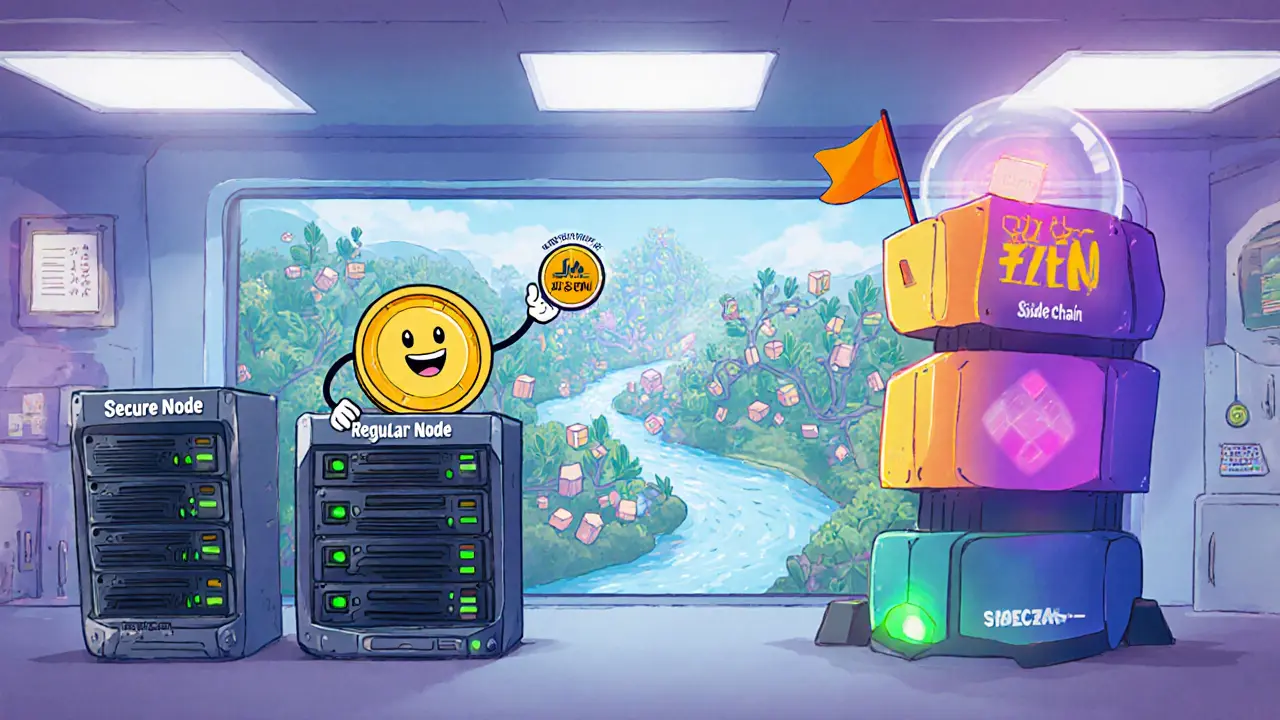Horizen (ZEN) Tokenomics Calculator
Node Participation Configuration
Block Reward Distribution
Based on current Horizen tokenomics:
- 60% goes to miners (block rewards)
- 30% rewards Secure and Super Nodes
- 10% goes to DAO treasury
Ever wondered what Horizen (ZEN) actually does and why it keeps popping up in crypto news? In simple terms, it’s a privacy‑first blockchain that lets you move value and run apps without exposing your data, while still playing nice with regulations.
TL;DR - Quick Takeaways
- Horizen (ZEN) is a privacy‑focused blockchain launched in 2017, originally as ZenCash.
- It runs on a modified Equihash Proof‑of‑Work algorithm and a three‑tier node system (regular, Secure, Super).
- Since 2025 ZEN lives on the Base blockchain as an ERC‑20 token, unlocking DeFi compatibility.
- Key tech: zk‑SNARKs for optional confidential transactions, and Zendoo sidechains for custom app‑specific blockchains.
- Tokenomics: 21million max supply, 60% mining rewards, 30% node rewards, 10% DAO treasury.
What Is Horizen (ZEN)?
Horizen (ZEN) is a privacy‑oriented blockchain platform that functions as both a cryptocurrency and a full‑stack ecosystem for decentralized applications. It began life as ZenCash, a fork of Zcash on 9January2018, keeping the core zero‑knowledge cryptography while adding layers for scalability and governance.
The platform’s mission is to give developers tools to build apps that keep user data confidential yet still satisfy regulatory requirements - a niche that many pure privacy coins ignore.
How Does Horizen Work? The Core Architecture
At the heart of Horizen lies a modified Proof‑of‑Work (PoW) algorithm called Equihash. This algorithm, also used by Zcash, is memory‑hard, making it ASIC‑resistant and more accessible to GPU miners.
What sets Horizen apart is its hierarchical node infrastructure:
- Regular nodes - keep the chain running and validate blocks.
- Secure Nodes - require a 42ZEN stake, 92% uptime, and a 200‑second challenge‑response time.
- Super Nodes - need a 500ZEN stake, 96% uptime, 8GB RAM, 100GB storage, and a 100‑second response window.
Privacy is optional. When users flag a transaction as “shielded,” Horizen employs zk‑SNARKs - zero‑knowledge proofs that let the network verify a transaction’s validity without revealing sender, receiver, or amount.
Zendoo Sidechains - Building Your Own Blockchain
The Zendoo framework lets developers spin up independent sidechains that interoperate with the main Horizen chain. Each sidechain can pick its own consensus mechanism, fee model, and privacy settings, dramatically reducing the time and cost of launching a custom blockchain.
Because sidechains settle their final state onto the main chain, they inherit Horizen’s security guarantees while retaining autonomy - a powerful combo for DeFi, gaming, or AI‑driven apps that need tailored rules.
Migration to Base and the ERC‑20 Era
In a bold move in early 2025, Horizen migrated to the Base blockchain, a layer‑2 solution built on Ethereum. This transition turned ZEN into an ERC‑20 token, preserving its privacy features while gaining instant access to the massive Ethereum DeFi ecosystem.
Post‑migration, ZEN can be used on popular DEXes like Uniswap and can integrate with Ethereum‑based lending, staking, and NFT platforms without sacrificing confidential transaction capabilities.
Tokenomics: Supply, Rewards, and Governance
Horizen follows a Bitcoin‑style supply cap of 21million ZEN, making it a “fair‑launched” coin - no ICO, no pre‑mined allocation. Block rewards are split as follows:
- 60% goes to miners who solve Equihash puzzles.
- 30% rewards Secure and Super Node operators.
- 10% feeds the Horizen DAO treasury, which funds ecosystem grants and development.
Holders can vote on protocol upgrades, sidechain funding proposals, and treasury allocations directly through on‑chain ballots, making ZEN both a utility and governance token.

Key Use Cases and Real‑World Adoption
1. Confidential DeFi - Platforms built on Zendoo can offer private swaps, lending, and yield farming while staying compliant with AML/KYC rules.
2. Enterprise Data Privacy - Companies use Horizen’s trusted execution environment to protect sensitive data in supply‑chain tracking or health‑care records.
3. Institutional Exposure - The Grayscale Horizen Trust provides qualified investors a regulated vehicle to hold ZEN, bridging the gap between retail crypto and traditional finance.
4. Secure Messaging - The Sphere app (see below) includes encrypted chat, making it a one‑stop privacy suite.
The Sphere - Your All‑In‑One Wallet
Horizen’s official desktop client, The Sphere, runs on macOS, Windows, and Linux. It offers a built‑in wallet, shielded transaction toggles, messaging, and node‑operation dashboards. While the UI is feature‑rich, newcomers often cite a learning curve-especially when setting up Secure or Super Nodes.
Comparison with Other Privacy Coins (2025 Snapshot)
| Feature | Horizen (ZEN) | Zcash (ZEC) | Monero (XMR) |
|---|---|---|---|
| Privacy Model | Optional shielded transactions via zk‑SNARKs | Selective privacy (shielded vs. transparent) | Always‑on RingCT |
| Main Consensus | Equihash PoW (now Base ERC‑20) | Equihash PoW | RandomX PoW |
| Token Type | ERC‑20 (post‑2025) | Native coin | Native coin |
| Sidechain Support | Zendoo custom sidechains | No native sidechains | No native sidechains |
| Regulatory Compliance | Built‑in KYC/AML hooks for institutions | Limited compliance tools | Minimal compliance |
| Market Rank (Sep2025) | #306 | #45 | #23 |
The table shows that Horizen’s biggest advantage is its sidechain flexibility and compliance‑ready design, while competitors excel in pure anonymity or market visibility.
Pros, Cons, and Common Pitfalls
Pros
- Strong privacy tech (zk‑SNARKs) with optional use.
- Sidechain ecosystem enables custom blockchain projects.
- ERC‑20 migration opens DeFi liquidity.
- Passive income via Secure/Super Nodes.
- Institutional bridge via Grayscale Trust.
Cons
- Relatively low market rank - limited mainstream adoption.
- Node operation demands technical know‑how and capital (ZEN stake, hardware).
- Regulatory uncertainty for privacy‑focused coins persists.
Pitfalls to avoid
- Skipping the 200‑second challenge test when setting up a Secure Node - you’ll lose rewards.
- Assuming all ZEN holdings are automatically shielded; you must enable the “private” flag per transaction.
- Storing large node stakes on unsecure wallets - use hardware wallets or the Sphere’s encrypted vault.
Getting Started: Three Paths for New Users
1. Casual trader - Buy ZEN on Binance, Coinbase, or Uniswap, transfer to The Sphere, and start sending shielded payments.
2. Node enthusiast - Acquire at least 42ZEN, set up a VPS with 2CPU cores, 4GB RAM, and install the Secure Node software. Follow Horizen’s step‑by‑step guide to meet the 92% uptime requirement.
3. Developer - Fork the Zendoo SDK from Horizen’s GitHub, design a sidechain with its own token, and deploy it. Use the Base bridge to interact with Ethereum DeFi contracts while keeping user data private.
Future Outlook and Price Forecast
Analysts project ZEN’s price could average around $56 by 2030, with a plausible range of $54-$65. The key drivers are:
- Increased institutional demand for compliant privacy solutions.
- Growth of the Zendoo sidechain market - more dApps mean more utility for ZEN.
- Broader DeFi integration via the Base ERC‑20 bridge.
Final Thoughts
Horizen (ZEN) offers a rare mix of privacy, sidechain flexibility, and regulatory‑ready features. If you care about keeping transaction data hidden while still being able to plug into mainstream DeFi, ZEN is worth a closer look. Just remember the technical steepness for node operators and keep an eye on global privacy‑coin regulations.

Frequently Asked Questions
What makes Horizontally (ZEN) different from other privacy coins?
Horizen combines optional zk‑SNARK privacy with a sidechain framework (Zendoo) and, since 2025, operates as an ERC‑20 token on Base. This lets developers build custom blockchains and access Ethereum DeFi while staying compliant, something most pure‑privacy coins like Monero don’t offer.
Do I need to run a node to use ZEN?
No. You can buy, store, and send ZEN like any other token using exchanges or the Sphere wallet. Node operation is optional and only needed if you want to earn the 30% node rewards or support the network.
How do I make a transaction private?
When you send ZEN from The Sphere (or any compatible wallet), toggle the “shielded” or “private” option before confirming. The wallet will then create a zk‑SNARK proof, and the network will mask the sender, receiver, and amount.
Can I earn interest on ZEN?
Yes. After the Base migration, ZEN can be supplied to DeFi platforms like Aave or Compound on Ethereum, earning interest just like any other ERC‑20 token. Some Horizen sidechains also offer native staking pools.
Is ZEN safe from government bans?
Horizen’s optional privacy means it can comply with KYC/AML requests when needed, which reduces the risk of outright bans. However, any cryptocurrency can face regulatory action, so stay updated on local laws.







Write a comment